Our town can offer you all this in half a day, but deciding among all its attractions can be complicated.
To make your visit easier we decided to create a path so that you can take in all the important places, from the Upper Town (Città Alta), or better yet from the heart: Piazza Vecchia (Old Square).
You'll find yourself surrounded by historical buildings, towers and churches, being besieged by its historic charm: you decide whether or not to let the city win your heart.
Heading in the opposite direction, you find yourself coming out of the Venetian Wall and arriving in the villages of the lower town, where you can admire the numerous works at the Accademia Carrara and Gamec (Gallery of Modern and Contemporary Art), arriving finally in the center of the modern city, with its shops and places to enjoy a bit of shopping or a happy hour.
Our town can offer you all this in half a day, but deciding among all its attractions can be complicated.
To make your visit easier we decided to create a path so that you can take in all the important places, from the Upper Town (Città Alta), or better yet from the heart: Piazza Vecchia (Old Square).
You'll find yourself surrounded by historical buildings, towers and churches, being besieged by its historic charm: you decide whether or not to let the city win your heart.
Heading in the opposite direction, you find yourself coming out of the Venetian Wall and arriving in the villages of the lower town, where you can admire the numerous works at the Accademia Carrara and Gamec (Gallery of Modern and Contemporary Art), arriving finally in the center of the modern city, with its shops and places to enjoy a bit of shopping or a happy hour.

Taking the most impressive means of transport in the city, the funicular (the cable car), you will find yourself catapulted into the Middle Ages of the councils and family names.
After you've looked around in the Piazza Vecchia (Old Square) we suggest that look at everything from above, climbing to the top of the Bell Tower.
If you want a bit of extra excitement wait for the hour, when the Civic Tower is filled with the ringing of bells; but if you're sensitive to loud sounds come down quickly to admire the wooden altarpiece of Lotto in the silent Santa Maria Maggiore Cathedral.
Taking the most impressive means of transport in the city, the funicular (the cable car), you will find yourself catapulted into the Middle Ages of the councils and family names.
After you've looked around in the Piazza Vecchia (Old Square) we suggest that look at everything from above, climbing to the top of the Bell Tower.
If you want a bit of extra excitement wait for the hour, when the Civic Tower is filled with the ringing of bells; but if you're sensitive to loud sounds come down quickly to admire the wooden altarpiece of Lotto in the silent Santa Maria Maggiore Cathedral.
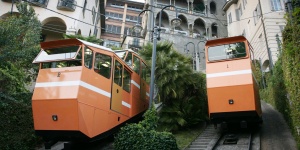
The Lower Funicular has been connecting the centre of Bergamo with the Upper Town (“Città Alta”) for more than 120 years, more precisely with Piazza Mercato delle Scarpe, where many business activities used to be carried out. The square (whose name means “shoes market square”) was used as a shoes market since 1430, while the building overlooking the square used to be the headquarter of the shoemakers’ guild and it currently hosts the funicular station.
The city’s funicular is really loved by Bergamo’s citizens, that couldn’t do without it: is there another means of transport allowing you to travel across time, passing through the ancient Venetian walls that used to defend Bergamo from the enemies’ attacks?
Two lovely orange coaches go up and down the hill, surrounded by beautiful gardens and amazing landscapes: when the sky is cloudless you can enjoy a breath-taking view on the Po plain and even catch sight of the Apennines!
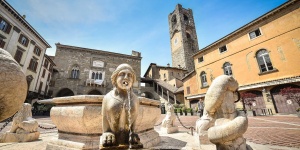
Piazza Vecchia represents the core of Città Alta: it has been the heart of political power for centuries and it keeps being one of the most popular places for Bergamo’s citizens to spend some time with friends.
Beauty is all around you if you have a seat at one of the square’s restaurants or cafes, having a drink, breakfast or even a romantic dinner. You can admire the building called “Palazzo della Ragione”, the oldest municipal seat in Lombardy, as well as the Torre Civica, a bell tower also called “Campanone”.
In the middle of the square is located the Contarini Fountain, which was donated to the city by the chief magistrate Alvise Contarini in 1780, while on the opposite side of Piazza Vecchia you can see the Palazzo Nuovo (“New Palace”), which served as Bergamo’s Town Hall until 1873 and is today the seat of the Angelo Mai Library. Its incredible collection includes ancient and precious books: incunabula, books from the 1500s, engravings, manuscripts and other inestimable artefacts making it one of the most outstanding libraries in Italy.
The geometrical layout of the buildings around the square is so harmonic that when Le Corbusier visited Bergamo he said “you can’t move a single stone, it would be a crime”
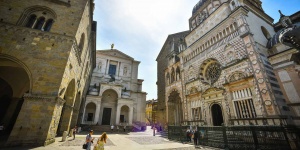
There’s a deep and old connection between the city and Santa Maria Maggiore Basilica, maybe due to the peculiar circumstances of its construction. During the first years of 1100, a terrible plague breakout spread across Europe, causing death and desolation. That’s why the people of Bergamo decided to ask the Virgin Mary to assist them: they vowed to dedicate a church to Her if she had protected them from being infected. Being men of their word, in 1137 Bergamo’s citizens started to built the Santa Maria Maggiore Basilica on the Piazza del Duomo, in the Upper Town. They actually acted big: the church turned out to be really beautiful, and it was adorned even more in the following centuries. Frescoes, stuccos, tapestries and wooden marquetry designed by the renowned artist Lorenzo Lotto decorate the inside of the building.
Santa Maria Maggiore also houses the funerary monument dedicated to Gaetano Donizetti, the famous music composer, symbol and representative of Bergamo all over the world.
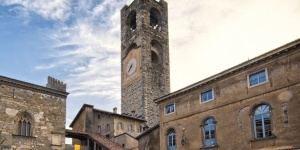
In the heart of Piazza Vecchia stands the Civic Tower, otherwise known as the Campanone, which with its height of 52.76 metres, offers a breathtaking panoramic view of the old town.

Colleoni was a very charismatic man, to the point that soldiers demolished a sacristy to erect the family chapel in his name.
Mercenary in the service of the Venetians, is now best known because of its coat of arms: three balls on a red and silver. There are many legends that are bound to this symbol, but what could interest you is touching the coat of arms on the gates to bring good luck.
Whether you are superstitious or not, we want continue to Colle Aperto : along the ancient Roman road "Corsarola" where you can get distracted by the many fashion and gastronomic shops.
Colleoni was a very charismatic man, to the point that soldiers demolished a sacristy to erect the family chapel in his name.
Mercenary in the service of the Venetians, is now best known because of its coat of arms: three balls on a red and silver. There are many legends that are bound to this symbol, but what could interest you is touching the coat of arms on the gates to bring good luck.
Whether you are superstitious or not, we want continue to Colle Aperto : along the ancient Roman road "Corsarola" where you can get distracted by the many fashion and gastronomic shops.
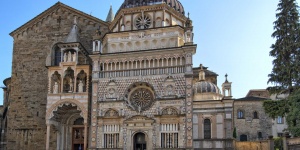
It’s surely the most beautiful building in Bergamo.
Its façade is decorated with red and white marble, an authentic Italian Renaissance masterpiece. The interiors are a fantastic collection of artworks: the equestrian statue of Bartolomeo Colleoni, mercenary captain from Bergamo, the marble sarcophaguses, the exquisite tomb of his daughter Medea, the inlayed wooden desks.
It would takes us pages and pages to describe them all, that’s why we suggest you to enter the chapel and let this art universe take you over!
Fun fact: legend has it that touching the coat of arms on the Chapel’s gate at midnight brings good luck. Believe it or not, it can be a nice excuse to take a walk to the lovely Città Alta by night!

From the Colle Aperto path along the Venetian walls will get you into the heart of the art: going from the St.
Augustine Door and The Accademia Carrara and The Gamec (Gallery of Modern and Contemporary Art) in just a few meters they will satisfy all your pictorial appetites. The walk will serve as a digestive help propelling you towards Porta Nuova, where you can enjoy a glimpse into the Piacentiniano Center (Lower Town).
Choose whether to turn left or right onto the little streets to enjoy a break in the elegant coffee or a bit 'of shopping in modern shops of Via XX Settembre.
From the Colle Aperto path along the Venetian walls will get you into the heart of the art: going from the St.
Augustine Door and The Accademia Carrara and The Gamec (Gallery of Modern and Contemporary Art) in just a few meters they will satisfy all your pictorial appetites. The walk will serve as a digestive help propelling you towards Porta Nuova, where you can enjoy a glimpse into the Piacentiniano Center (Lower Town).
Choose whether to turn left or right onto the little streets to enjoy a break in the elegant coffee or a bit 'of shopping in modern shops of Via XX Settembre.
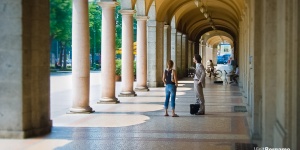
The centre of modern Bergamo is the ideal place to walk in the name of shopping, amusement, art and history!
This ancient and elegant part of the city is called Centro Piacentiniano, an amazing architectural complex that used to host the old city trade fair. This very same atmosphere still enlivens the area, thanks to the numerous markets and events filling the city centre with colours and scents all over the year. Walking along the Sentierone pedestrian way, passing by the imposing chestnut trees and beyond the Porta Nuova propylaea, you will get to via XX Settembre: here you can admire Palazzo Frizzoni, Bergamo’s City Hall.
From here on, enjoy the local life: boutiques, shops, alleys and beautiful small squares, in the name of amusement. Last but not least, how about a good coffee or a drink in one of the numerous cafes and bars?
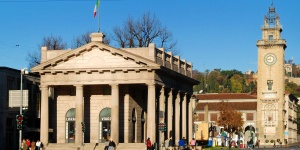
Train is the best way to get to Bergamo: going out of the railway station, you have an immediate and wonderful overview of the city. Your sight follows a straight line going up to Porta Nuova, the heart of the Lower Town. Raise your head just a little bit and your eyes will be filled with the majestic and perfect landscape of the Upper Town.
In 1837, the old wicket gate nestled in the “Muraine”, the massive XV Century walls that used to surround the hills and go down to the Lower Town and the old districts, was replaced by an iron gate opening a breach in the defensive walls: it is Porta Nuova (“New Gate”).
This place represented the main gateway to the commercial area of Bergamo for a very long time. Today, it is still the main junction around which the main streets and monuments of the Lower Town lie.
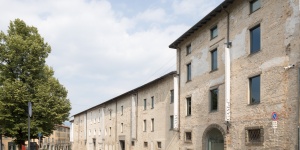
The Gallery of Modern and Contemporary Art was founded in 1991 right in front of the Accademia Carrara Picture Gallery, in a restored fifteenth-century architectural complex, formerly intended as a monastery. The diversified programming - open to experimentation with contemporary languages and to multidisciplinarity, and at the same time anchored to the roots of the institution and its heritage - has made it into a multifaceted space that has been able to involve different audiences over the years. With its 1500 square metres of exhibition space, it is a place that welcomes contemporary art in all its forms: temporary personal and collective exhibitions by international artists, new and emerging projects and a rich calendar of collateral activities designed for different audiences are the strong point of the Gallery’s cultural policy, which is a dynamic place for comparison, analysis and cultural integration, in constant evolution.
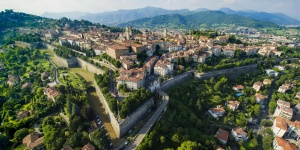
Bergamo wouldn’t be the same without its impressive Venetian Walls. This spectacular circuit is over six km long: it’s the perfect place to take a romantic walk and enjoy wonderful sunsets, and it has been enclosing the beauties of the Upper Town for more than four centuries.
The priceless artistic and cultural value of the Venetian Walls is demonstrated by their recognition as a Unesco World Heritage site.
They were built starting from 1561 by the Republic of Venice in order to face enemies attacks, but History was kind with them: maybe due to their stunning beauty, they never underwent any siege. That is why they remained almost intact to the present day.
The Walls consist of 14 bastions, 2 platforms, 100 embrasures for cannons, 2 armouries, four gates, not to mention the underground structures featuring sallies, passages and tunnels: don’t miss the chance to walk inside the Walls and to visit the casemates of San Michele and San Giovanni!
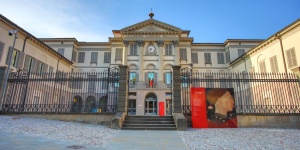
Museum
The Accademia Carrara in Bergamo is a museum with a specific and, in some ways, unique identity, closely tied to its origins and history. Unlike many Italian museums, Carrara is the result of the ambitious project of Giacomo Carrara (1714-1796) to promote the establishment of a cultural institution that would combine pleasure and education, serving as both an art gallery and a painting school. The success of this idea is evidenced by the extensive series of large and small donations made over more than two centuries by individuals and institutions. These, along with a few targeted acquisitions, have complemented the original foundation laid by the founder. Besides Carrara, leading the long list of donors are notable figures such as Guglielmo Lochis, Giovanni Morelli, Federico Zeri, and Mario Scaglia. Their collections form the backbone of the museum and contribute to defining the diverse and articulated character of its heritage.
The renewed visitor's journey is organized in 16 differently-sized rooms, showcasing a total of 350 exhibited works, including paintings, sculptures, medals, and plaques. Visitors thus have the opportunity to embark on a five-century journey through the history of Italian art, from the Renaissance to the nineteenth century, encountering masterpieces by Pisanello, Mantegna, Botticelli, Raphael, Titian, Lotto, Moroni, Hayez, and Pellizza da Volpedo.